
views
Ensuring Compatible Tank Conditions
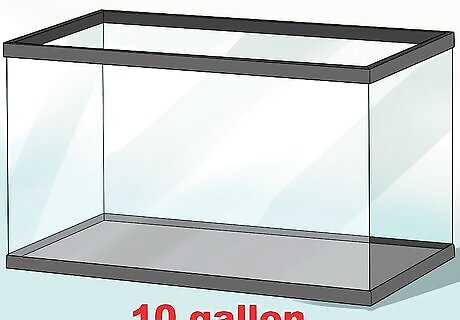
Allow for plenty of space. It is important that you avoid overstocking your tank. The general rule is that you should have room for one gallon of water for each inch of fish in your tank. So, a ten-gallon tank can safely accommodate ten one-inch-long fish. This is a very important rule to keep in mind if you are looking to care for schools of fish. Overstocking your tank can lead to a build-up of toxic waste products. It will also necessitate additional cleanings. Some larger species, such as full-grown goldfish, will require additional tank space. Fish that move around a great deal may also need extra room.
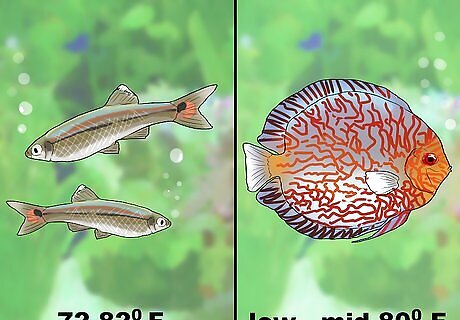
Go with either cold water or warm water fish. You need to choose fish that all thrive at right around the same temperature. You can accommodate only a few degrees’ difference in preferred temperatures or your fish will suffer. A tropical fish generally cannot live comfortably alongside a cold water fish. Your tank equipment needs will also differ greatly as some fish require heaters and lights and others do not. For example, a white cloud minnow is a type of cold water fish that requires consistent temperatures between 72-82 degrees Fahrenheit (22-28 degrees Celsius) in order to thrive. Discus, on the other hand, need a warmer tank that stays in the low to mid 80s Fahrenheit (high 20s Celsius). If your tank is the wrong temperature, your fish may become more susceptible to disease. They may also move more slowly and refuse to eat.
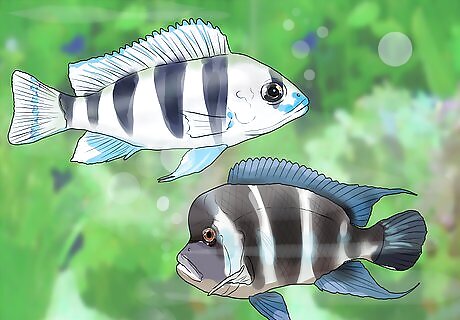
Choose fish with similar pH level requirements. Make sure that the fish that you buy fall into the same range on the pH spectrum. Many fish that you buy directly from the store are acclimated to a neutral pH, but will do even better in a pH customized to them. For example, a tropical African cichlid does best in alkaline water. Most freshwater fish prefer a pH somewhere between 6.5 and 7.5. Don’t forget to take into account the pH needs of any live plants that you will add into your tank as well. For example, many fresh water plants require a pH between 6.0 and 7.5, a fairly wide range that can overlap with the needs of a number of fish.
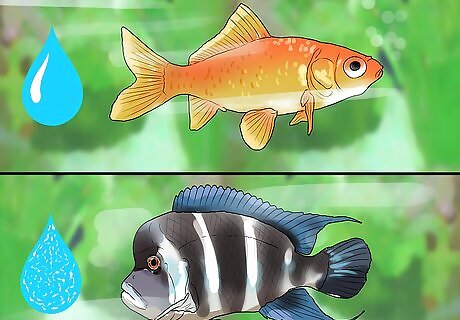
Go with either freshwater or saltwater fish. The tank filtration needs between these two fish groups are generally different, with tropical fish requiring less in the way of filtration and cleaning. The temperature and pH requirements between them are also dissimilar, which really can’t be worked around, even by a skilled aquarist. For example, a goldfish would not live well alongside a cichlid. The goldfish requires colder temperatures and freshwater. In contrast, the cichlid thrives in warmer temperatures and needs hard or brackish water conditions.
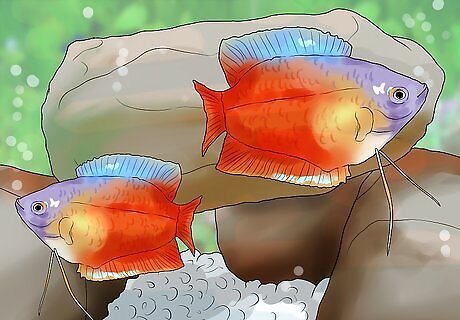
Provide plenty of hiding spots. Even if you are pretty sure that the fish will get along, it is a good idea to create an interesting tank environment that can provide some “alone” space for an individual fish. Some fish are generally social and friendly, but also need to get away every now and then. This will also minimize any stress associated with overcrowding. For example, gouramis are fish that love to hide. They establish a dominance system and, during these contests, the weaker fish will often hide from the stronger one.
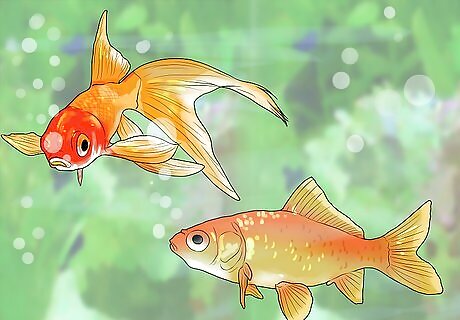
Select colorful, active fish for an eye-catching tank. Some fishes, like the goldfish, will provide a great deal of color and activity. Other fish, such as the shark fish, are less colorful but demonstrate very interesting schooling behaviors. Some fish are bottom-feeders and prefer to hide-out during the daytime, such as the kuhli loach, making them almost impossible to spot.
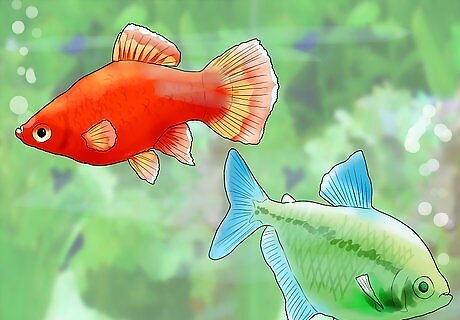
Take your experience level into account. Make sure to consider how comfortable you are caring for fish. If this is your first tank, you may want to go with a relatively simply combination of just one or two low-maintenance types of fish. Single-species tanks are especially good for fish that prefer to swim in schools. Oscars are dominant, large fish that don’t generally tolerate other species tank mates well. They will try to eat smaller fish especially. Puffer fishes are good options for experienced aquarists, but they also prefer to be around their own species. Platies and GloFish, for example, are great beginner fish that enjoy living in community tanks.
Ensuring Compatible Fish Behaviors and Biology

Choose fish with similar eating patterns. Some fish will eat anything and everything in sight, including other fish. Some fish are more picky eaters that will refuse to eat if bullied by others. Some fish require a certain number of pellets, whereas others just need a pinch of flakes. Get to know what the nutritional requirements are for your fish. Make sure to consider the algae needs of your fish as well. Some fish, like plecos, are friendly algae eaters unless that food is not available. Then, they can turn more aggressive.
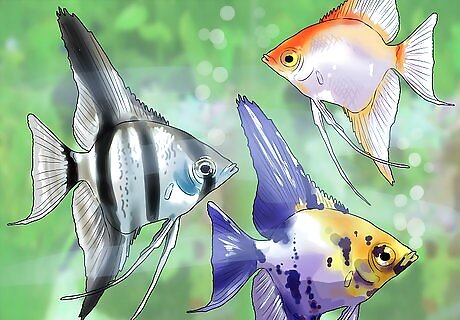
Stock your tank with similar size fish. General wisdom suggests that big fish will usually bully and eat little fish. Try to pair fish together that can grow alongside one another to a similar size at maturity. Angelfish, for example, are known to stalk and kill smaller fish in their tanks. A medium size fish or a schooling fish can sometimes withstand the pressures from larger fish.
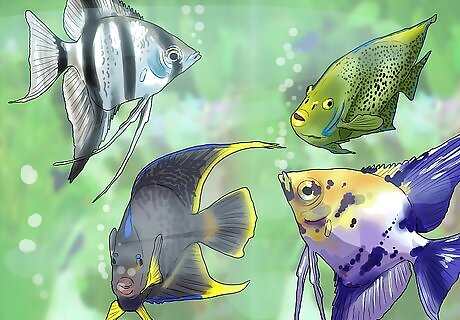
Choose fish with similar paces of movement. You don’t want to look into your tank and see fast-moving fish chasing fish that move a bit more slowly. Learn about how much movement a certain fish species prefers. Try not to pair an overly athletic fish with aggressive tendencies with a fish that is smaller, slower, and more docile.
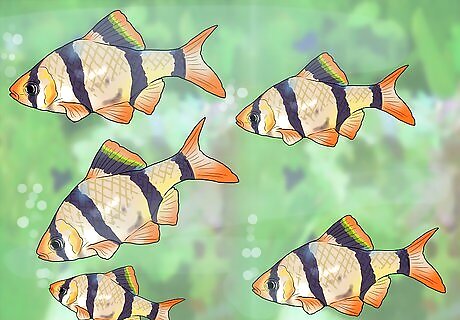
Get a school of fish. Some fish just do better when living and playing in groups. Tropical fish, unlike their freshwater counterparts, seem to particularly prefer living in schools. Try to establish a school of at least five fish, but be aware that you may need to boost your numbers even more. Tiger barbs, for example, are known to develop a temper unless they are placed with an extremely large school of 20 to 50 fish.

Buy fish that are not predatory based on sex. Try to find out if the fish that you are interested in do best with those of the same sex or the opposite. This especially important information to consider with regard to spawning behaviors. For example, a male Betta fish really needs to be the only male in residence in a tank. Whereas, a female Betta does fine with other females.
Watching Out for Problems
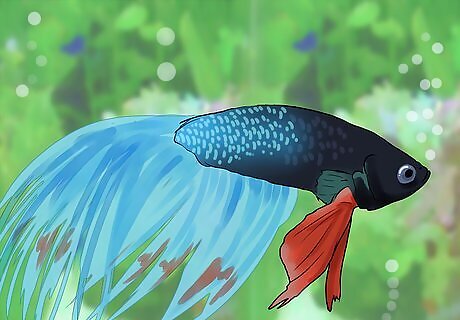
Look out for signs of fish stress. Fish will show that they are not doing well through their behaviors and physical appearance. They may start to look overly pale, losing their usual markings. They may start to show signs of injury, such as damaged fins. They may also refuse to eat or leave a hide-out space. Stressed fish are also more likely to become ill. For example, Ichthyophthirius multifiliis (also known as white spot disease, ich, or ick) is a potentially fatal infection that is caused by a parasite present in most freshwater aquariums. Stressed fish have a harder time defending themselves from the parasite, which attaches to the fish and feeds on its skin. The first symptom of this condition is usually white spots on the fish’s body, followed by irritation, respiratory distress, and then death.
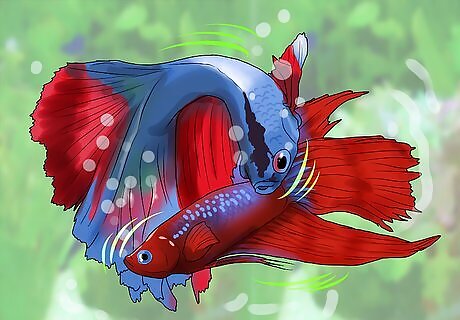
Pay particular attention during fish spawning periods. When your fish begin to spawn, this is a time of high stress for all of their tank mates. Fish will pair up and can injure themselves in the mating process. Fish will also be left out from pairings and can behave aggressively as a result. It is often a good idea to move mating pairs into another tank. Also, be aware of what will happen to the offspring created. Livebearers may create babies that other fish in the tank will try to eat, if adequate hiding spaces are not provided.
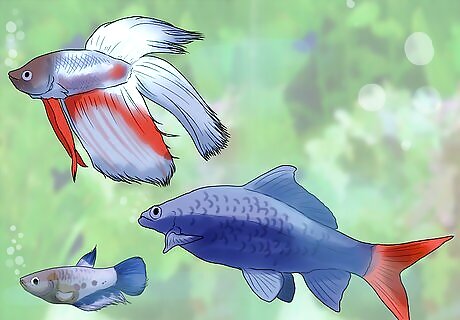
Recognize the unique challenges presented by “bully” species. Fish keepers have labeled certain species “aggressive” or “semi-aggressive” because those types have a tendency to exhibit bullying behaviors in community tanks. If you choose to buy a known “bully” species, such as a red-tailed shark or cichlid, you’ll need to keep an extra close eye on your tank. You may also need to remove the bully fish and place it in an alternative tank. So, have an extra tank and materials on-hand.

















Comments
0 comment